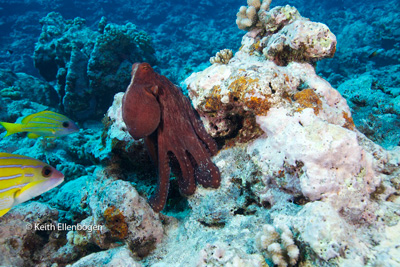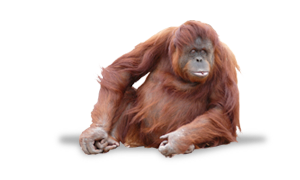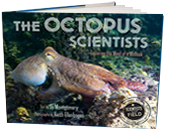The Octopus Scientists:
Exploring the Mind of a Mollusk
(Scientists in the Field Series)
HMH Books for Young Readers, ISBN 0544232704
Chapter 1
The ocean is the world’s largest wilderness, covering 70 percent of the surface of the globe. But this vast blue territory is even bigger than it looks from land, or even from space. It’s a three-dimensional realm that accounts for more than 95 percent of all livable space on the planet—and most of it is unexplored.
The sea is home to creatures who rival the strangest sci-fi aliens anyone ever imagined. We’re searching for one of them now: an animal with a baggy, boneless body, eight sucker-laden arms attached to its head, a beak like a parrot and venom like a snake. It can shift its shape, change its color, squirt ink and pour itself through the tiniest opening—or jet away through the sea faster than many swimmers can follow.
We’re looking for octopus—the Pacific day octopus, to be exact, one of perhaps 250 octopus species that exist on the planet. This species grows to more than four feet long. They’re not rare or endangered. Should be pretty easy to find, right?
“Ptttttthhhth!”
A spout like a small whale’s shoots from her snorkel as Jennifer Mather pulls her silver-haired head from the water. She looks through her prescription facemask and waits for the rest of us to surface from the sea. Soon we answer her with a chorus of spouts.
Jennifer pulls the snorkel from her mouth. “Find anything?” she asks.

No—we are out here looking for holes.
“That hole in the middle of that dead coral looks good,” says Jennifer, pointing. Near it, she has found an empty shell. She holds it up to show us. That makes two pieces of evidence that we could be closing in on our quarry. But it won’t be as easy as it might seem.
What does it look like? Well, that’s the problem: Octopus cyanea (it’s named after Cyan, a water nymph from Greek mythology) might be fat and red, skinny and white, tall and brown, or a combination of colors and shapes. It might have stripes or spots or splotches–and then, the next second, it might look completely different. Or become utterly invisible.
Not only can it pour its three-foot-long arms and melon-sized body through a hole the size of a thimble; it can also hide in plain sight. As well as changing color to match its surroundings, it can instantly sprout little projections all over its skin called papillae (pap-PILL-ay) to make it look exactly like a piece of algae or coral or rock.
Which is what the octopuses in this part of Opunohu Bay may be doing at this very moment—if they’re here at all.
“Octopuses are hard to find,” concedes Jennifer. Though she works at University of Lethbridge in the center of Canada, far from any ocean, she’s been probing the mysteries of these quirky, changeable animals for forty years. She’s conducted experiments with the giant Pacific octopus, which can grow to more than 100 pounds, in Seattle Aquarium. She’s studied the five-inch-long pygmy octopus in Florida and the common octopus in Bermuda. And she’s watched the Pacific day octopus before, off the island of Hawaii and the common octopus in Bonaire.
Everything about them fascinates her, but especially this: “Octopuses are smart,” she says—and that’s thought to be rare for an invertebrate (in-VERT-a-brit). Invertebrates include insects, spiders, worms, snails, starfish and clams; they have no bones, and usually have very small brains. (Starfish and clams have no brains at all!)
Octopuses are, in fact, related to snails and clams—they’re all mollusks. Most mollusks have shells—but not octos. That makes the octopus an unprotected packet of tasty protein for predators. Almost anything big enough can eat an octopus: it is the main prey of marine mammals, sharks, and many fishes. Humans eat them, too.
But what the octopus lacks in protective shell, it makes up in smarts. In fact, having no shell might be the very reason octopuses are so smart: they have to be. If you’re a clam, you can just sit around, wait for food to float to you, and depend on your shell to protect you. Leaving the ancestral shell behind allowed octopuses more active lives, but also brought dangers demanding snap judgments. If a hungry shark approaches, should the octopus hide in a hole? Change color or shape? Squirt a smokescreen of ink? Or squirt a hanging blob of ink, one that looks like an octopus—while the octopus itself jets away?
To both hunt and to hide, an octopus must choose wisely among many options–and it has evolved a big brain to help it do so. Jennifer, a professor of psychology, is interested in how these intelligent invertebrates make decisions. That’s why she’s invited a team of octopus experts here to Moorea: to find out how octopuses decide what to eat–while avoiding being eaten themselves.
What good can come from studying the life of an octopus? “There is an appalling amount we don’t know about the ocean,” says Jennifer—so much so, in fact, that the most elementary research might leads to unexpected breakthroughs.
Jennifer points out that people are already using knowledge of octopuses to model “soft” robots, which roam over rough ground much better than vehicles with wheels. And that’s only a beginning. “Octopuses’ arms are full of suction cups that are marvels of manipulation,” she notes. “How come we’re not copying them? Well, because we don’t understand them.” Another marvel: Female octopuses inactivate and store sperm from the males for months—then activate the sperm when the moment is right to lay eggs. Talk about family planning! Jennifer wonders, “How come we aren’t finding out how they do that?”
But perhaps even more important than helping us design new gadgets or even improve our medical knowledge, studying octopuses may provide answers to some of life’s most intriguing questions. Octopuses represent a different route to high intelligence—which is why Jennifer was asked to give a talk about them for the Search for Extra Terrestrial Intelligence institute. Might extra-terrestrials look and act more like octopuses than like us?
“What are the possibilities of life on Earth?” asks Jennifer. “Lots—and we’ll only know by finding out about marine animals.”
Dripping with seawater, she holds up the two-inch shell for our inspection. “Is this a drill hole?” she asks. “I can’t tell.”
David Scheel leans his six-foot frame down to look. A behavioral ecologist and an expert on the giant Pacific octopus, David is a professor of marine biology at Alaska Pacific University in Anchorage. He’s seen lots of drill holes. Drilling is one of several ways the ingenious octopus can get at the tasty meat inside even the strongest shells.
Sometimes an octopus can just pop the two halves of a clam’s shell open with its strong suckers. With just one of its biggest suckers, one of David’s giants can lift up to thirty pounds. Or the octopus might chip at a shell with its beak, which is as strong as a parrot’s. If the shell is too thick, the octo might drill. An octopus has a ribbon of teeth on its tongue called a radula (RAD-jula), an organ unique to mollusks, which the octopus uses to drill holes and other mollusks use to shred prey. And the octo has another trick up its sleeve: it can also dissolve the calcium in the shell by squirting it with acid from a gland in the front of its head. Once the hole is deep enough, the octopus can inject venom from a different gland, in the back of its head, through the hole to paralyze the prey. The venom even starts dissolving the meal, like meat tenderizer works on a juicy steak.
But whoever ate the mollusk who lived in this shell apparently didn’t drill. “No,” says David, after a careful look, “I don’t see a hole. But look what I found!” Just minutes ago he was investigating another possible octopus home—a crevice under a rock—and he collected what he found just outside it. He unfolds his palm and reveals the orange claw and shell (also called a carapace) of a crab. The claw was piled on top of the carapace, and both of them on top of a clam shell. Nobody in the sea is tidier than an octopus!
Lots of different items may appear on an octopus’ menu–everything from clams to snails to fellow octopuses. (This is a hazard for an octopus seeking a mate; their first date could end with dinner, with one of them being the main course!) Giant Pacific octopuses sometimes catch and eat birds. One was seen dining on an otter (who was probably dead when the octopus found it).
But crabs are among octopuses’ very favorite foods. And the remains of this crab bears the signature of an octopus—as Tatiana Leite, a marine biologist from Brazil, confirms the moment David hands his find to her. Beneath her face mask, the edges of Tatiana’s brown eyes crinkle into a smile. “Yeah!” she agrees. “It’s intact, and the inside is completely clean. A fish would have crunched it all up.”
Jennifer, David, and Tatiana share the same mission: to find out what the Pacific day octopuses of Moorea are eating, and why. But each scientist has a slightly different lens through which they view their mysterious study animal. Jennifer, the head of our team, as a psychologist, is convinced that each octopus’ personality plays an important role in food choices. She expects that bolder, more adventurous octopuses will venture further from their dens and choose a wider variety of prey. David’s specialty is behavioral ecology. He’s fascinated by the dynamics of predators and their prey. He suspects that octopuses prefer big crabs, but those who can’t find and catch them make do with smaller prey and a wider menu. Tatiana is a marine ecologist. One of her special interests is how an animal’s environment affects how it behaves. She predicts that the octopuses who live in a more complex and varied environment will have a more diverse diet.
Which is true may be important for many different reasons. But one of them is finding out what octopuses eat, and why, might help scientists discover whether octopus populations are in danger or not. Octopuses, as we can see, are very difficult to count. That makes it hard to tell whether any octopus species are endangered or declining. Some species in some areas might be: the common octopus might be over-fished in some waters; others kinds, like the exceptionally beautiful mimic octopus, could be over-collected for the saltwater aquarium trade. Other threats, like pollution and global warming, might be hurting octopus species, too—either by harming them directly, or by affecting their favorite prey. Is there enough food for each octopus species? Nobody knows—or can even begin to find out—until scientists discover exactly what they eat and why. This study might well turn out to be a model for other studies on different octopus species elsewhere.
At Jennifer’s invitation, each researcher has come here to test his or her own idea, or hypothesis. A new scuba diver who had never snorkeled before, I’ve joined the team from New Hampshire to write this book about their quest; underwater photographer Keith Ellenbogen, an expert scuba diver and snorkeler, came along from New York to take the pictures on these pages. Soon another researcher, Keely Langford, an eagle-eyed interpreter with the Vancouver Aquarium in Canada, will join us to help.
There’s lots to do. We’ll be collecting and classifying the shells around octopuses’ homes. We’ll be carefully surveying the plants, animals, and rocks on the sea bottom where the octopuses live. We even plan to give each octopus we find a personality test!
But first we have to find the shape-shifting, hole-hiding octopuses—animals who are masters of escape and disguise.
“I think an octopus had a meal here, without a doubt,” says David.
The question is: where is it now?

